
via DOT
May 31, 2018 By Nathaly Pesantez
The Department of Transportation has revealed a much-anticipated proposal for safety improvements along Thomson Avenue by LaGuardia Community College in a two-pronged plan that includes short term measures and a subsequent years-long overhaul to the area.
The proposal, presented at the college Tuesday night, was prompted by the 2015 death of a 16-year-old high school student on the avenue, and builds on an initial 2016 plan put forth by the agency. The new proposal outlines traffic calming improvements that can be implemented as soon as this fall, and unfinished concepts that will take years to plan out.
Short-term changes include adding crosswalks at certain intersections and potentially adding parking to the curb in front of the college, while the longer, capital project improvements focus on changing traffic flow, new crosswalks, and landscaping.
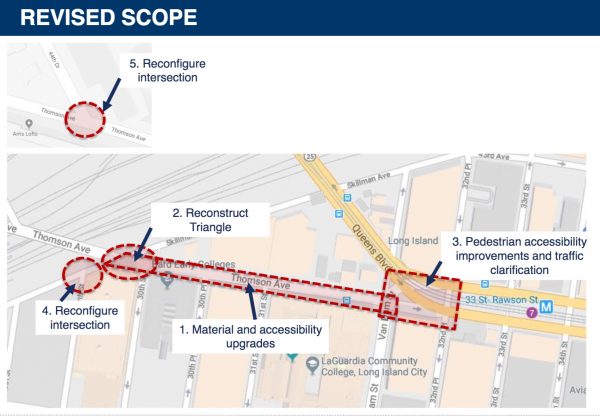
The scope of the work mainly covers the length of Thomson Avenue from Van Dam Street to Skillman Avenue, and the intersections of 29th Street and Skillman Avenue and Thomson Avenue and 44th Drive. The proposal also adds a one-block section of Queens Boulevard and Van Dam Street spanning to 32nd Place.
Short Term Proposals
The short term component of the plan mainly features two areas on Thomson Avenue and Van Dam Street. Proposals in this section could take up to two years to be carried out.
The DOT is proposing to add a total of five crosswalks at the intersection of Thomson Avenue and Van Dam Street in the short-term. The main crosswalks include one running on the north side of Thomson Avenue to the nearby pedestrian triangle, with another running parallel to Van Dam Street toward the same triangle.
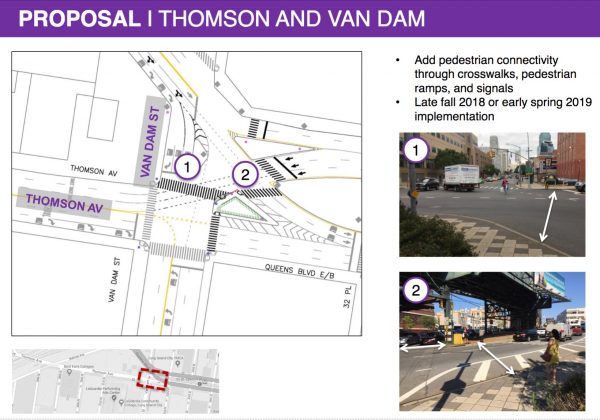
via DOT
Dan Wagner, a DOT Pedestrian Projects planner, said this area has a number of “missing crosswalks” that combined with changed traffic signals and pedestrian ramps would improve connectivity and help pedestrians make safer choices when crossing.
The crosswalks can be installed in fall 2018 or early spring 2019, Wagner said, and would depend on the agency working out technical factors like signal pole positioning.
“When we see pedestrians crossing in what seems like very dangerous intersections, and there aren’t crosswalks there, that tells us there’s a pedestrian desire line,” Wagner said.
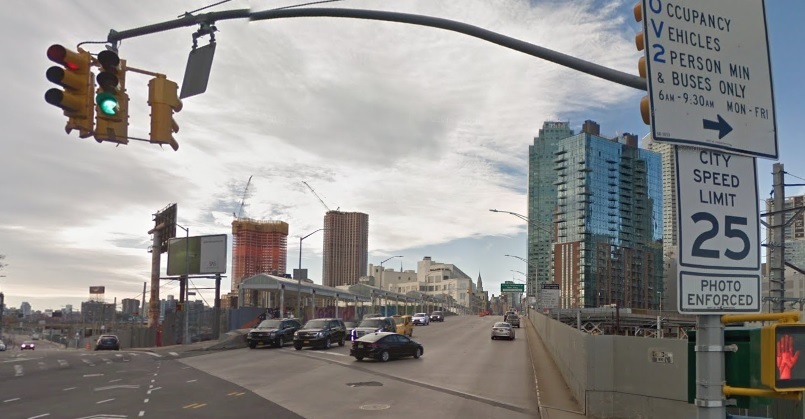
One side of Thomson Bride lacks a sidewalk (Google)
Also in the short term are several plans for the length of Thomson Avenue from Skillman Avenue to Van Dam Street. Proposals include making sure pedestrians don’t venture into the opposite side of the Thomson Avenue bridge, as there is no infrastructure for pedestrians there, and looking at the mid block crosswalk between Van Dam and 31st Streets, as cars often block the walkway there.
The DOT will also study the feasibility of adding parking during off-peak hours on the curb directly in front of the college. “This would help provide traffic calming, pedestrian safety, and protection from moving vehicles,” Wagner said.
Long Term Capital Project
The long-term, $17 million component of the proposal, is entirely conceptual, Wagner said. But some concrete ideas, however, are in place.
The DOT will look into upgrading traffic patterns and further improving pedestrian walkways and connectivity at the same Thomson Avenue and Van Dam Street section intersection.
“It’s a difficult intersection, and we’re thinking that with capital funds we can do something a little more innovative than is out there now,” Wagner said. The agency will also look at upgrading sidewalk materials through the section.
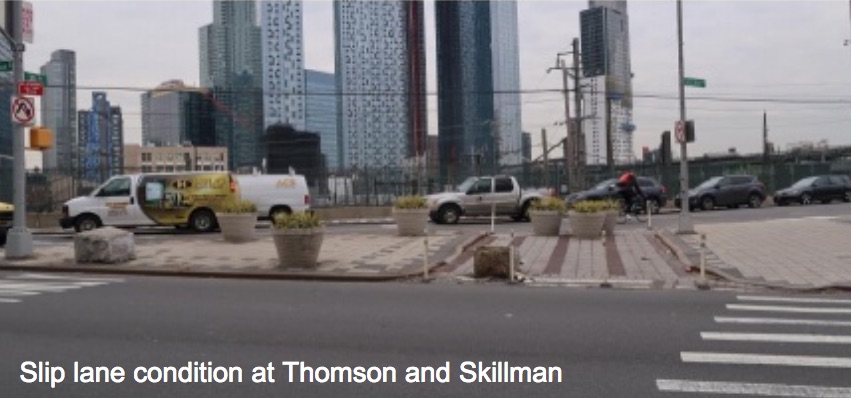
via DOT
The DOT is considering building out the slip-lane closure, which has been closed for several years and maintained with temporary materials. further west at Skillman Avenue. And at the intersection of Skillman Avenue and 29th Street, a curb extension will be built out to force turning cars to slow down and increase motorist visibility.
Along Thomson Avenue, the agency will study enhancing the sidewalks with upgraded materials, furniture, and landscaping. The “staple”-like bollards, currently impeding to pedestrians and wheelchair users who use Access-A-Ride, could be removed and replaced with modern pole bollards. Bicycle racks can also be installed through the corridor.
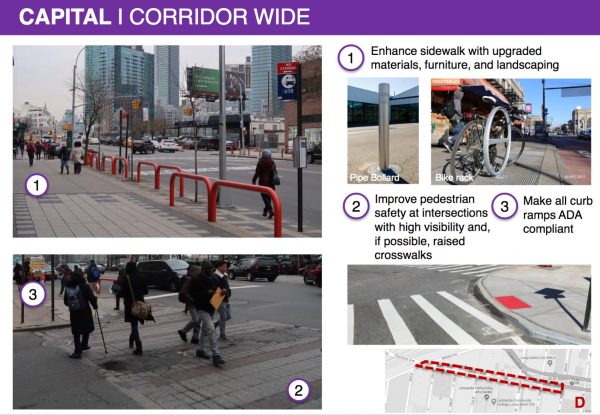
via DOT
The DOT will also look at making all curb ramps along Thomson Avenue ADA compliant, and create high visibility, possibly raised crosswalks.
Finally, at Thomson Avenue and 44th Drive, the agency is considering installing a crosswalk on the northeast side of Thomson Avenue by the Forge, and a curb extension for traffic calming and pedestrian visibility.
Wagner said it would take three years at the minimum to do the actual design, with construction possibly beginning in 2022 at the earliest.
Attendee Feedback
The majority of attendees–current students at the college and professors–spoke to the immediate need for traffic calming outside the school, and recalled incidents that have almost cost them their lives. The DOT’s proposals address many of these concerns, but others, however, say the plan still doesn’t do enough.
Anthony Tellez, a student at the college, asked why the DOT’s proposal doesn’t include expanding the sidewalks adjacent the school.The original 2016 plan called for the sidewalk to extend out by seven feet.
“Why not expand them? During class hours, it gets really congested on Thomson Avenue,” Tellez said. “I’ve seen multiple students go to the edge of the sidewalk near the road, where cars are just zooming by. That concerns me.”
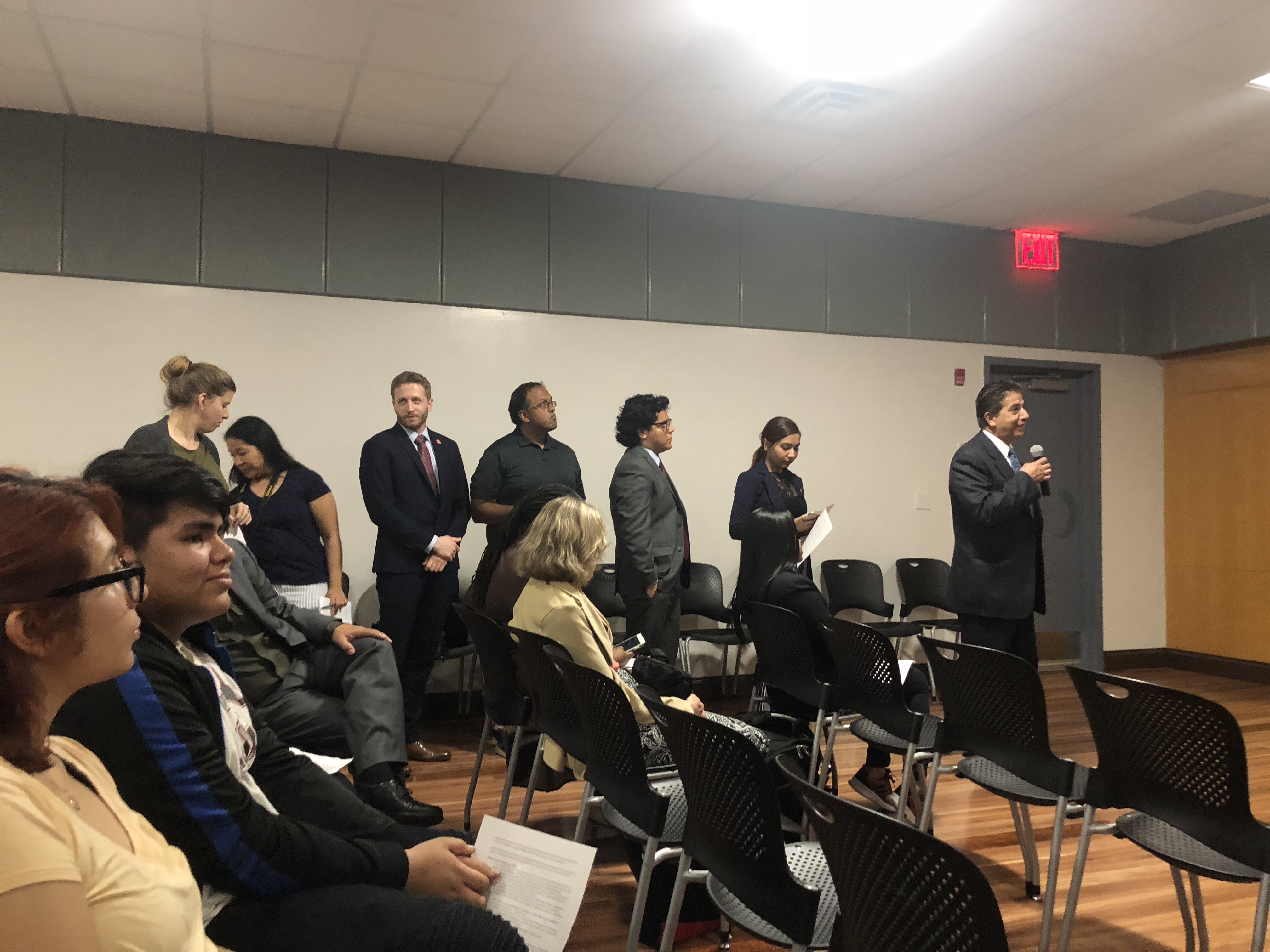
Attendees lining up to speak at the DOT Thomson Avenue presentation last night. Photo: Nathaly Pesantez.
The DOT said earlier in the presentation that its original sidewalk extension idea is actually costly and less effective than other safety measures.
Joby Jacob, a biology professor at the college and creator of a petition put forth last year demanding that the DOT include more improvements for pedestrians and cyclists in the area, said the new project “is not putting our students and faculty members as the primary priority.”
“We have six lanes for folks who are driving, and we have overflowing sidewalks,” Jacob said. He suggested that the agency could remove travel lanes on Thomson Avenue, and, along with many attendees, called for protected bike lanes near the school.
The DOT insisted that the capital project only consist of concepts, and does not preclude protected bike lanes in the future.
In a statement released after the Tuesday meeting, the DOT said the presented visuals were concepts in development, and that they received valuable insights during the meeting. “…We look forward to continuing the conversation with all community stakeholders,” a DOT spokesperson said.
Council Member Jimmy Van Bramer, who said the area needs a lot of work to be safer for everyone, said the plan is a “real step in the right direction.”
“This $17 million project will create a safer environment for the tens of thousands of students, faculty, young people & professionals who walk & drive along this corridor every single day,” Van Bramer said.
He added: “We must work towards Vision Zero in every single corner of our City so that no pedestrian, driver or cyclist loses their life while using City streets.”
Thomson Van Dam May2018 by Queens Post on Scribd
2 Comments

* Should be reduced to a single lane in each direction with no turning lanes.
* due to the large number of pedestrians, a pedestrian island between the lanes would be a good idea.
* Since a large number of students arrive by bike there should be a protected bikelane.
* reduction of vehicle capacity on this street could reduce bridge congestion.
* most people using this street to get to the bridge are from Long Island and are dodging the tunnel toll.
Your last point is another reason why we need tolls on all crossings and congestion pricing. Our local streets are filled with motorists trying to avoid tolls on the tunnel and RFK bridges. Enough is enough.